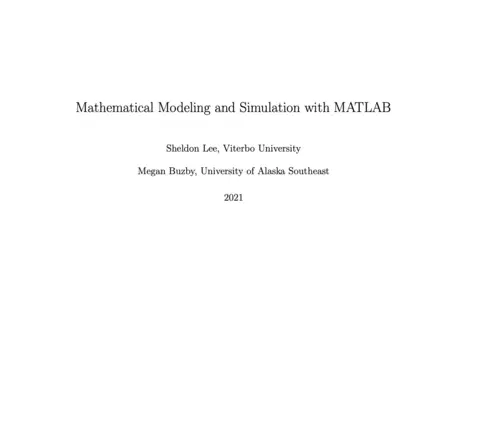
Mathematical Modeling and Simulation with MATLAB
![]()
![]()
![]()
![]()
![]()
Sheldon Lee, Viterbo University
Megan Buzby, University of Alaska Southeast
Copyright Year:
Publisher: University of Alaska Southeast
Language: English
Formats Available
Conditions of Use
![]() Attribution-ShareAlike
Attribution-ShareAlike
CC BY-SA
Reviews
The book introduces some common mathematical modeling methods such as iterative modeling, matrices modeling, discrete modeling, continuous modeling, and stochastic modeling. The modeling methods could be beneficial to readers in mathematics,... read more
![]()
![]()
![]()
![]()
![]()
Reviewed by Yang Zhao, Assistant Professor, Taylor University on 12/13/22
Comprehensiveness
The book introduces some common mathematical modeling methods such as iterative modeling, matrices modeling, discrete modeling, continuous modeling, and stochastic modeling. The modeling methods could be beneficial to readers in mathematics, physics, chemistry, biology, economics, engineering, and computer science. MATLAB programming is popular in both academia and industry for modeling, analyzing, and simulating.
Content Accuracy
The book describes the mathematical concepts and the modeling methods in text and equations accurately. It introduces MATLAB commands and programming techniques correctly. The example MATLAB codes work well to produce identical results in the book.
Relevance/Longevity
The mathematical concepts, modeling methods, and example problems meet a variety of modeling needs, which will be beneficial to the readers in the long run. However, the MATLAB example codes might be invalid in the future, because MathWorks produces new MATLAB versions annually and they might change the MATLAB programming syntax.
It would be better to specify the MATLAB version in the textbook and update the example codes in the future.
Clarity
This book explains the terminologies and concepts using text, tables, and mathematical equations. It demonstrates example problems using description, mathematical derivation, and graphs.
Consistency
The terminologies, definitions, and concepts are consistent. They match the standards in the bibliography.
Modularity
This book contains seven chapters and six appendices. Each chapter discusses a relatively independent topic. A one- or two-credit-hour course may use this book to introduce modeling methods and programming skills.
Organization/Structure/Flow
The book introduces the overall organization of the contents in Chapter 1. It elaborates on MATLAB programming in Chapter 2, which is the foundation of the rest of the book. It talks about the specific modeling methods in Chapters 4-7.
Interface
Most of the graphs are sharp with captions and descriptions. The curves in the same plot have different line styles or colors. The MATLAB commands and codes are highlighted in the text. The important equations have equation numbers. The links help the reader to locate the content quickly.
Grammatical Errors
Grammatical errors are not found.
Cultural Relevance
The cultural relevance issue is not found.
CommentsThere are exercise problems in each chapter and selected solutions in the appendix for the readers to practice.
The book prefers the prerequisites in calculus, differential equations, linear systems, nonlinear systems and linearization, probability, and stochastics, even though with a brief introduction to these topics.
I would recommend adopting this book in a Junior- or Senior-level course.
Table of Contents
- 1. Introduction
- 2. Programming in MATLAB
- 3. Iterative Methods
- 4. Matrices
- 5. Discrete Models
- 6. Continuous Models
- 7. Stochastic Modeling
- A. In-class Activities and Exercises
- B. Solutions to in-class Exercises
- C. Selected Solutions
- D. MATLAB Commands
- E. Debugging
- F. Completed Proofs
- Index
About the Book
About the Contributors
Authors
Sheldon Lee, Viterbo University
Megan Buzby, University of Alaska Southeast
